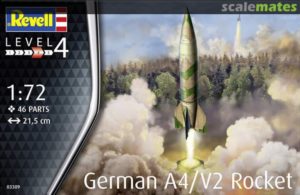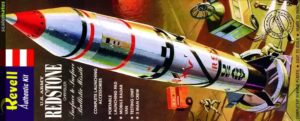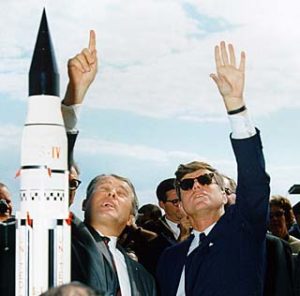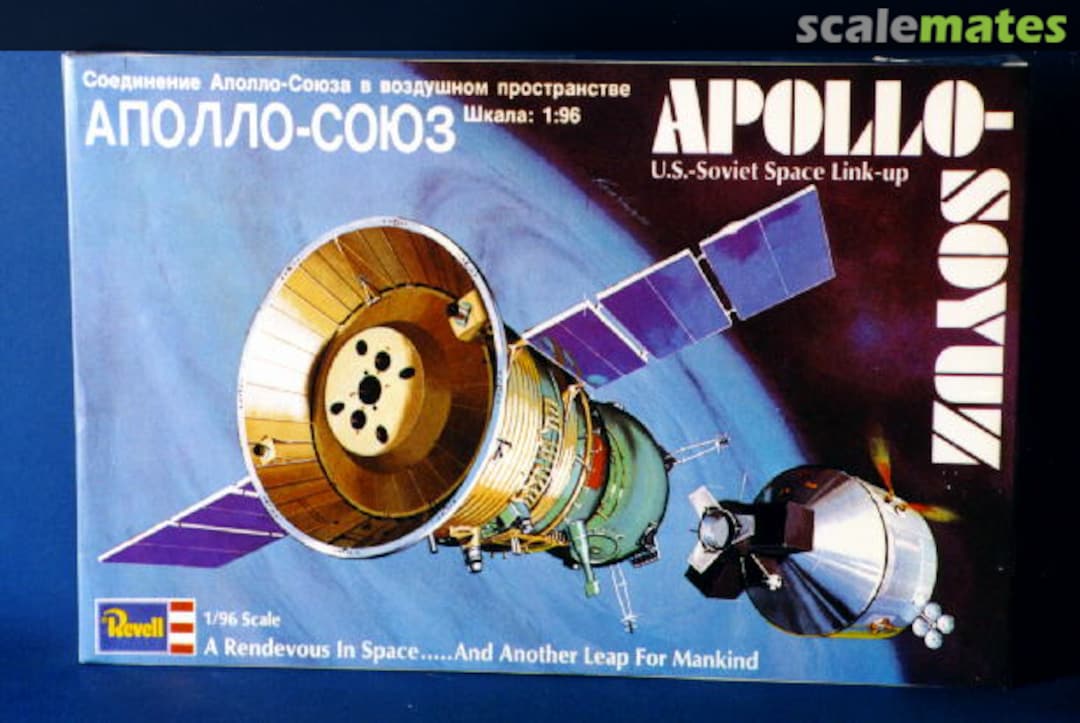Apollo-Sojus, Revell 1997, vorgestellt durch Scalemates
Vielleicht war es schon immer so, dass die Völker einander gemessen haben, vermutlich meist im Kampf. Der Kampf auf dem Kriegsschauplatz, blutig und tödlich, der Kampf in der Arena gegen Tiere. Oder für geistig erhabenere, seit, wie man vermutet 2000 v. Chr. die pan-hellenischen Spiele, welche in der modernen Zeit weltweit ausgefochten werden. Wie misst man sich im Kalten Krieg? Ein physisches Kämpfen ist nicht möglich. Viele Tiere geben rechtzeitig auf, wenn es klar ist, wer der stärkere ist. Beim Humanoiden ist es so, gewonnen hat der, der nicht dauerhaft liegen bleibt. Das ist schlecht für die zwei größten Nationen, die UdSSR und die USA, weil ja jeder noch nach solch einem Kampf weiter existieren möchte. Der Zweite Weltkrieg, der Startpunkt der Globalisierung, als die Beute durch die beiden Großen aufgeteilt wurde, da war ja nicht klar, welches System das bessere oder dominantere ist. Wie bei Monopoly wurden die Felder okkupiert und bestellt. Mit der Kapitulation Japans endete der Zweite Weltkrieg. Unmittelbar begannen die rund acht, eher lokalen Kriege, motiviert durch die Dekolonisation und Blockbildung, um auch das örtliche Machtgefüge zu definieren. Der zeitlich letzte dieser Kriege, der Koreakrieg, machte bewusst, dass die großen beiden Mächte sich nicht selbst gegenüber stehen müssen, sondern ein kleineres Land gefunden wird, wo der Konflikt stellvertretend ausgetragen wird. Aktuell wird an so einer Art von Krieg in der Ukraine gearbeitet.

Scalemate presentiert Revells deutsche A4/V2 Rakete
Nach diesem geschichtlichen Ausflug kommen wir zurück in das Jahr… Das ist nun schwierig zu definieren. Nachdem im Deutschen Reich das Fundament für die Raumfahrt entwickelt wurde, allerdings um Sprengköpfe möglichst weit ins gegnerische Spielfeld zu tragen, war die Technik und die Techniker hoch begehrt. Die beiden großen Siegermächte versuchten zu ergattern, was sie nur konnten. Die Beute wurde jeweils nach Hause verfrachtet und beide Großnationen versuchten jetzt damit was anzufangen. Die USA konnten einige dieser Raketen, Pläne, aber vor allem die Techniker, die sich selbst bemühten in die amerikanische Gefangenschaft zu geraten. Die UdSSR erhielt über die Teilung Deutschlands, der sowjetischen Besatzungszone, Zugang zu den Werkstätten. Wenige Techniker gerieten in den Einflussbereich der Sowjetunion, meist die, die es vorzogen, im östlichen Teil Deutschlands zu bleiben. Beide Großnationen erkannten rasch, welches Potenzial diese Technik birgt und gaben sich viel Mühe in den Kriegswirren des Deutschen Reiches so viel zu okkupieren, was nur möglich war. Man muss hier wohl Sergei Pawlowitsch Koroljownennen, der für die sowjetische zielorientierte Requirierung im Deutschen Reich federführend war, zumal er selbst sich seit den 1930ern mit der Raketenentwicklung beschäftigte, wusste er, worauf es ankam. Die USA, mit ihrer Operation Overcasthaben alles mitgenommen, was nach Rakete aussah. Sicherlich auch unterstützt durch die freiwilligen Kriegsgefangenen, die daran gearbeitet hatten und vorsorglich Material der Roten Armee vorenthalten hat. Koroljow, ein exzellenter Techniker, gelang es, sich die in die fehlenden, in die USA abtransportierten Puzzle zu erarbeiten. In den USA wurde das eroberte Material inklusive der Personen vorerst eingelagert. Zu sehr war Mensch und Material mit dem Faschismus kontaminiert, der Stolz zu groß.
Da man auch in den USA bestrebt war, die Rakete als Waffe zu benutzen, war die US-Air Force damit beauftragt. Sie entwickelten die Atlas-Rakete von 1946 bis 1957, es gab eine Unterbrechung, weil Gelder für den Koreakrieg benötigt wurden. Dennoch hob die erste dieses Raketentyps vier Monate früher, am 21. August 1957 in der Nahe des kasachischen Baikonur ab. Die sowjetische Rakete, damals R-7 benannt, ist noch heute als Sojus-Rakete bekannt, eine über die Jahre weiterentwickelte Familie von Raketen und noch im Einsatz. Mit bislang 1936 Starts, ein solides Arbeitspferd. Eine Rakete aus dieser Familie brachte auch die Sputnik-Stateliten 1957 ins All, was aus Angst der Zündfunke war, die USA endgültig in das Rennen um den Weltraum eintreten zu lassen. Dort war immer noch die US Air Force beauftragt, den Wettlauf aufzunehmen und zu gewinnen. Doch es gelang der US Air Force nicht, an die erfolgreiche Atlas Rakete anzuknüpfen. Mit dem Amtsende des 70 jährigen 34. Präsidenten der USA hielt ein 27 Jahre jüngerer und dynamischer Präsident Einzug in das Weiße Haus, der nicht diese kategorisch ablehnende Haltung gegenüber der geschichtlichen Herkunft der inzwischen in Huntsville (Alabama) angesiedelten Deutschen mit ihrem Team hatte. Der bereits auf deutscher Seite forschende Pionier der Raumfahrt, Wernher von Braun, dessen frühes Ziel es war, zu den Planeten zu reisen, blieb auch in den USA nicht untätig. Konnte er durch die Rüstungsprojekte im Deutschen Reich seinen Traum vorantreiben, gelang es ihm auch in den USA an Gelder zu kommen. So wurde die auf der “Aggregat 4 / Vergeltungswaffe 2” basierende Redstone Rakete parallel zu der Atlas der US Air Force entwickelt. Sie sollte nicht nur Sprengköpfe transportieren, sondern auch den ersten Satelliten der USA und im Zuge des Mercury-Programms 1961 den ersten Amerikaner in den Weltraum.

Scalemate presentiert Revells U.S. Army Redstone
Dem Sputnik-Schock 1957, folgten die ersten Hunde im Weltraum, der erste Mann und die erste Frau als Kosmonauten im All, der erste Weltraumspaziergang (das Verlassen des Raumschiffs), viel längere Aufenthalte in der Erdumlaufbahn als die USA, die ersten Bilder von der Rückseite des Mondes, die erste Sonde auf dem Mond, die erste Raumstation im Erdorbit und der erste Roboter auf dem Mond. Die konsequente Arbeit Korojows bis 1966 hatte sich hier im Wettlauf deutlich bezahlt gemacht.
In den USA wollte man diese sowjetische Überlegenheit nicht hinnehmen. Aufmerksamen Beobachtern wurde auch bewusst, dass die US Air Force durch ihre militärischen Aufgaben überlastet war, auch Weltraumflüge voranzutreiben, zumal die Gruppe um Wernher von Braun, gemessen an den zur Verfügung gestellten Mitteln, effizienter arbeitete. So wurde 1958 die zivile US-Bundesbehörde für Raumfahrt und Flugwissenschaft gegründet, und das Team um von Braun schnell integriert. Bereits 1959 entstanden die ersten Studien zur Saturn Rakete, zwei Jahre vor Kennedys berühmter Rede: We choose to go to the Moon.

Und nach dieser einleitenden Vorgeschichte soll dann Teil 2 folgen, mit der in Bünde 1956 gegründeten Firma Revell und den schönen Modellen um die Raumfahrt.

